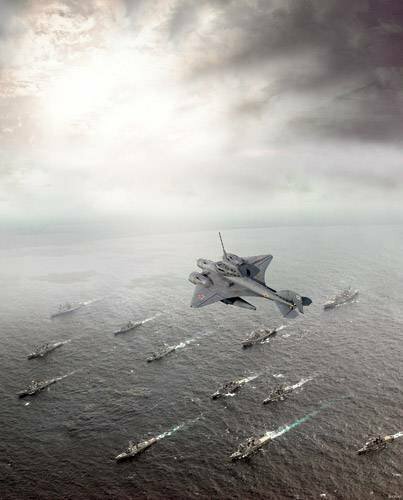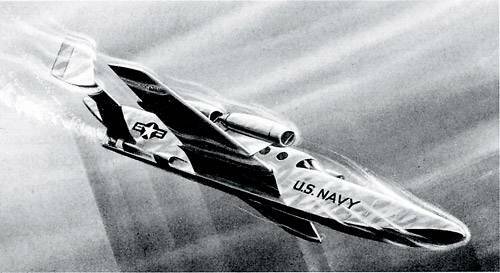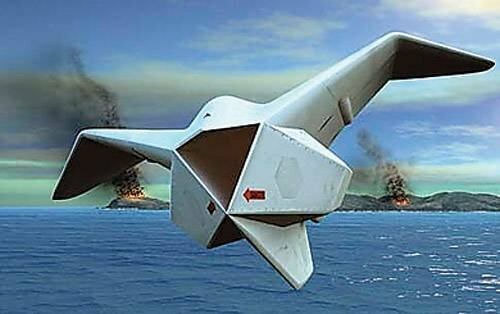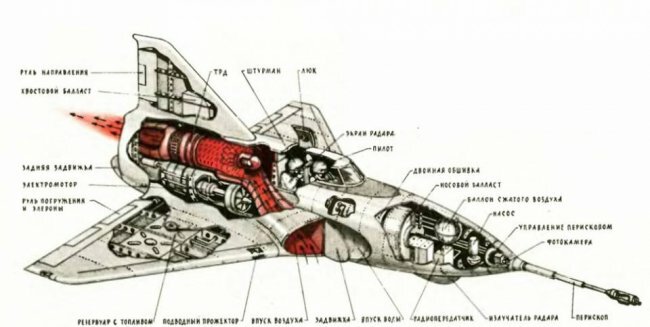Submarine fighters and aircraft carriers

Tactical characteristics of LPL
Crew: 3 people. // Take-off weight: 15 000 kg // Flight speed: 100 (~ 200) knots. (km / h) // Flight range: 800 km // Ceiling: 2500 m // Number and type of aircraft engines: 3 x AM-34 // Takeoff power: 3 x 1200 hp // Max. additional excitement during takeoff / landing and diving: 4 – 5 points // Submerged speed: 4 – 5 knots // Depth of immersion: 45 m // Power reserve under water: 45 miles // Underwater autonomy: 48 h // Power of rowing motor: 10 hp // Dive duration: 1,5 minutes // Ascent duration: 1,8 minutes // Armament: • 18-inch. torpedo: 2 pcs. • twin machine gun: 2 pcs.
The aircraft detects the enemy from the air and delivers a disorienting blow. Then, moving away from the line of sight, the car sits on the water and plunges to a depth of several meters in a minute and a half. The target is destroyed by an unexpected torpedo strike. In case of a miss, the device rises to the surface in two minutes and takes off to repeat the air attack. A bunch of three such machines creates an impassable barrier for any enemy ship. Such a designer Boris Petrovich Ushakov saw his flying submarine.
Of course, such a project could not appear. If there is an amphibious vehicle, why not teach the plane to dive? It all started in the 30s. Second-year cadet of the Higher Naval Engineering School named. F.E. Dzerzhinsky (Leningrad), Boris Petrovich Ushakov, embodied on paper the idea of a flying submarine (LPL), or rather, a submarine aircraft.
In 1934, he provided a voluminous drawing folder along with a report to the department of his high school. The project for a long time "walked" through the corridors, departments and classrooms of the school, received the "secret" stamp; Ushakov refined the submarine scheme more than once in accordance with the comments received. In 1935, he received three copyright certificates for various components of his design, and in April, 1936, the project was sent to the Military Research Committee (NIVK, later - TsNIIVK) and at the same time to the Naval Academy. The detailed and generally positive report on the work of Ushakov, prepared by the captain of the first rank A.P. Surin
Only in 1937, the project was endorsed by professor NIVK head of the department of tactics of military vehicles Leonid Egorovich Goncharov: "It is desirable to continue the development of the project to reveal the reality of its implementation," wrote the professor. The document was also studied and approved by the head of the NIVK, a military engineer of the I rank, Karl Leopoldovich Grigaytis. In 1937-1938, the project nevertheless continued to “walk” along the corridors. No one believed in his reality. At first, he was included in the work plan of department "B" NIVK, where, after graduating from college, Ushakov entered as a military technician of the first rank, then was expelled again, and the young inventor continued to work independently.
Winged submarine Donald Reid Commander-2
Developed with the participation of the US Navy in the 1964 year, this submarine in the form in which it is shown in the diagram and figure, never existed in reality
Airplane aquarium
Submarine gradually acquired the final appearance and "stuffing". Externally, the device is much more like a plane than a submarine. An all-metal machine weighing in 15 tons with a crew of three theoretically had to reach speeds of up to 200 km / h and have a range in 800 km. The speed under water is 3 – 4 of the node, the depth of the dive is 45 m, the range of the swim is 5 – 6 km. The plane was to be set in motion by three X-NUMX-powerful AM-1000 engines designed by Alexander Mikulin. Superchargers allowed the engines to carry out short-term forcing with an increase in power to 34 hp.
It is worth noting that at that time the AM-34 were the most promising aviation engines of production of the USSR. The design of the 12-cylinder piston power unit in many respects anticipated the development of aircraft engines of the well-known Rolls-Royce, Daimler-Benz and Packard firms - only the technical “closeness” of the USSR prevented Mikulin from gaining worldwide fame.
Inside, the aircraft had six hermetic compartments: three for engines, one for living, one for battery, and one for horsepower electric motor, horsepower 10. The residential compartment was not the cockpit, and was used only for scuba diving. During the dive, the cockpit was flooded, as was a whole series of leaky compartments. This made it possible to make part of the fuselage of lightweight materials that were not designed for high pressure. The wings were completely filled with water by gravity through the scraps on the flaps - to equalize the internal and external pressure.
Fuel and oil systems were shut off shortly before full immersion. In this case, the pipelines were sealed. The plane was covered with anti-corrosion coatings (varnish and paint). The dive took place in four stages: first, the engine compartments were closed up, then the radiator and battery compartments, then the control was switched to the underwater, finally, the crew switched to a sealed compartment. The aircraft was armed with two 18-inch torpedoes and two machine guns.
10 January 1938, the project was re-reviewed by the second department NIVK. Nevertheless, everyone understood that the project was “raw” and huge funds would be spent on its implementation, and the result could be zero. The years were very dangerous, mass repressions were going on and it was possible to get under the hot hand even for an inadvertently dropped word or “wrong” surname. The committee made a number of serious remarks, expressing doubts about the ability of the Ushakov aircraft to rise into the sky, catch up with the departing ship under water, etc. To divert the eyes, it was proposed to make a model and test it in the pool. There are no more references to the Soviet submarine aircraft. Ushakov worked for many years in shipbuilding on ekranoplans and ships on air wings. And from the flying boat there were only schemes and drawings.

Submarine Conveir, 1964: this project could be one of the most successful in the development of winged submarines, if not for the resistance of US Senator Allen Elender, who unexpectedly closed funding
Engine under the hood
A similar Ushakov project in the United States appeared many years later. As in the USSR, its author was an enthusiast, whose works were considered insane and unrealizable. A fanatical designer and inventor, electronics engineer Donald Reid was engaged in the development of submarines and the creation of their models from 1954 of the year. At some point he had the idea to build the world's first flying submarine.
Reid assembled a number of models of flying submarines, and when he was convinced of their performance, he began to build a full-fledged device. For this, he used mainly the details of the decommissioned aircraft. The first copy of the Reid RFS-1 Submarine Reid assembled for the 1961 year. The device was registered as an aircraft with the number N1740 and was driven by a 65-strong Xcoming Lyun-4-cylinder aircraft engine. In 1962, the aircraft RFS-1 piloted by Donald Bruce flew 23 meters above the surface of the Shrewsbury River in New Jersey. It was not possible to carry out experiments on immersion: serious design defects had an effect.
To transform the aircraft into a submarine, the pilot had to remove the propeller and close the engine with a rubber cap, working on the diving bell principle. In the tail there was an electric motor with 1 horsepower. (to move under water). The cabin was not sealed - the pilot was forced to use scuba gear.
A number of popular science journals were written about the Reid project, and in 1964, the US Navy became interested in it. In the same year, the second copy of the boat was built - Commander-2 (the first received the “military” name Commander-1). 9 July 1964, the aircraft reached a speed of 100 km / h and completed the first dive. In the first model of the aircraft during the immersion, the remaining fuel from the tanks was pumped into the reservoir, and water was pumped into the tanks to make the structure heavier. Thus, the RFS-1 could not re-fly. The second modification should have lost this disadvantage, but this did not happen, as it would have had to recycle the entire structure. After all, fuel tanks were also used as diving tanks.
However, the design was too low power and light to be used for military purposes. Soon the leadership of the Navy cooled to the project and curtailed funding. Until his death in 1991, Reid tried to “promote” his project, but he did not succeed.
In 2004, his son Bruce wrote and published the book Flying Submarine: story Reid RFS-1 flying submarine inventions. The RFS-1 aircraft itself is stored in the aviation museum in Pennsylvania.
However, some sources claim that the Reid project has evolved. The US Navy has decided to build an “Aeroship” - a two-body aircraft capable of diving. Allegedly, in 1968, at the World Industrial Exhibition, this aircraft made a spectacular landing on water, and then diving and ascending. Nevertheless, the official program of the exhibition of that year (held in San Antonio) did not include a demonstration of a submarine plane. Further traces of this structure are lost under the “secret” stamp.

The Cormorant unmanned submarine, developed by Skunk Works (USA) and tested as a full-size model in the 2006 year. All the details about this project are hidden under the heading "top secret"
Underwater rock 1960-x
In April, 1945, a man by the name of Houston Harrington suddenly appeared on the horizon, applying for a patent on “Combining an Airplane and a Submarine”. The patent was obtained on December 25, but it did not go further. The Harrington submarine looked very beautiful, but nothing was known about its flight data or underwater qualities. Subsequently, Harrington became famous in the United States as the owner of the record label Atomic-H.
Another patent for a similar design was obtained in the US in 1956 year. It was created by American Donald Doolittle (with Raid). This design was repelled rather than from an aircraft, but from a submarine. The movement under water was traditionally provided by an electric motor, but the flight was carried out with the help of two jet engines.
In 1964, Conveir offered the United States Air Force to develop a small submarine aircraft. Documents were submitted - drawings, diagrams, and even some fantastic "photos." Conveir received a technical assignment from the Bureau of Naval Armaments, which included 280 – 420 km / h speed, dive depth 460 m, flight range 555 – 955 km, etc. Despite the clearly overstated requirements, the contract was concluded.
The project implemented the idea of Reid on the use of fuel tanks as tanks for immersion, but the fuel did not merge, but entered into other special tanks - for better load distribution under water. The residential compartment and the engine compartment were sealed, the remaining parts of the submarine were filled with water. In the manufacture of submarines planned to use ultra-light and ultra-strong materials, including titanium. The team consisted of two people. It was made several models that have been successfully tested.
The end came unexpectedly: in 1966, the well-known Senator Allen Elender, the head of the Senate Arms Committee, frankly ridiculed the draft and ordered the development to stop. The full-size sample was never made.
Border under the castle
Inventors are not too rushed to create vehicles for two environments. The main problem is the high difference in air and water density. While the aircraft should be as light as possible, the submarine, on the contrary, tends to weighting to achieve maximum efficiency. It is necessary to create completely different aerodynamic and hydrodynamic concepts for water and for air. For example, the wings that support the aircraft in the air, only interfere under water. Structural strength also plays a big role and leads to the weighting of the boat-plane, since such a unit must withstand very high water pressure.
Developed by Skunk Works, the Cormorant (Cormorant) project is an unmanned aerial vehicle powered by two jet engines. "Cormorant" can start from special underwater carriers - submarines of the "Ohio" class. The reserve of the underwater course of the "Cormorant" is very small - only to get to the surface, and then, after completing the surface task, return to the carrier. Wings underwater drone folded and do not interfere with movement.
The body of the aircraft is made of titanium, there are no voids in it (they are filled with material like foam), and the body geometry resembles a cross between a seagull and a stealth.
Tests were carried out on individual systems of "Cormorant", its reduced model was tested, as well as a full-scale model, devoid of part of the structural elements. But since 2007, information about the development of the "Cormorant" is practically absent, probably, having fallen under the classic neck "top secret".
Submarine aircraft carriers
Of course, there were many projects that are close in principle to the submarine aircraft. The most characteristic - and fully realized - were the so-called "submarine aircraft carriers" - submarines, carrying airplanes.
In 1942, the construction of such devices began in Japan, and in 1944, two submarines, the aircraft carriers I-400 and I-401, were launched. They carried on themselves three specialized fighter “Seyran” M6A. Light aircraft started in the surface position of the boat using a catapult, the launch was carried out in 30 minutes. Aircraft could independently return to the ground base after the operation. However, there was a modification of "Seyran" and without a chassis - for kamikazes. Their launch was easier, 14 minutes for everything. But the end of the war was approaching. The construction of the remaining mortgaged boats (402, 403 and 404 numbers) has been suspended due to the high cost of the project. "Seyran" also produced the entire 20 pieces. Fighter cockpits were sealed in case you have to start right out of the water. In addition, two lightweight submarines I-13 and I-14 were made to carry one fighter. The first combat “swim” of the submarines was planned for 17 August 1945, but they didn’t reach the target, then it was postponed until 25 August, and Japan capitulated on September 2, not allowing the ambitious project to materialize. However, the Japanese managed to conduct combat tests of a small submarine-aircraft carrier I-25. In September, a seaplane took off from a prototype of a similar boat, 1942, and dropped two incendiary bombs in the Ohio forests. The effect was almost zero: the forest fire did not start. But it can be said that such constructions were still used for combat purposes.
Submarine aircraft carriers built not only Japan. Back in 1928, the UK converted the HMS M2 boat for taking off and landing light seaplanes. The submarine sank in the 1932 year, and this experience in England is no longer repeated. The only similar French attempt was the submarine "Pirate", built in 1930, and sank in 1942. In the USSR, the development of special submarines for similar purposes was carried out in the 1930-x (series 14-bis). Airplanes for them developed I.V. Chetverikov (project CPL-1). The tiny plane could be prepared for take-off in just five minutes, and the container for it was a tube with a diameter of 2,5 and a length of 7,5 m. in 1936 year. But after the work on the carriers for Chetverikov’s aircraft was discontinued (1938 year), the project lost its relevance.
In Germany, a similar project was developed in 1939 – 1940. Ar.231 V1 and Ar.231 V2 light aircraft were designed. True, the long time required for assembly (10 minutes), and the incredibly difficult control of the resulting plane, brought the project to naught. Another German attempt was the construction of the Fa-330 reconnaissance autogyro for take-off from limited space, but this unit also did not work well when tested.

Information